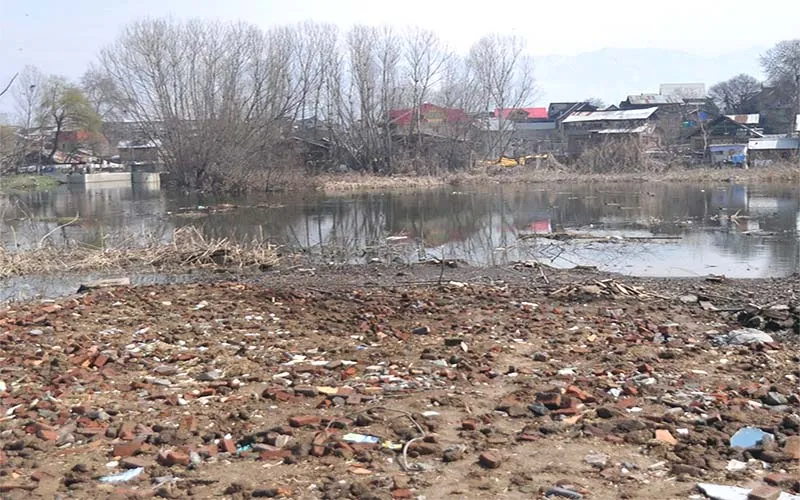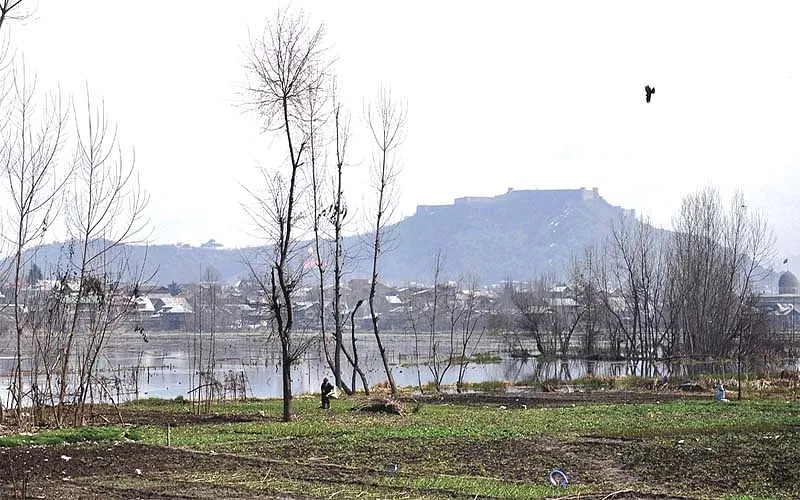KhushalSar, Gil Sar Lakes—the two famous water bodies that were altered by human interventions, mass scale encroachments, climate variability—leading to its degraded water quality, diminished habitat, lowering native fish and downsized tourist influx, are finally now being healed and brought back to their pristine glory.
“Srinagar district administration has a comprehensive restoration programme for the twin KhushalSar, Gil Sar Lakes in Downtown Srinagar,” Deputy Commissioner, Srinagar, Mohammad Aijaz, told Greater Kashmir.
“The administration has adopted a mass level community approach to reach out to the people with a vibrant message. We are also implementing several restoration activities in order to bring back the pristine glory of the famed twin water bodies,” the DC said, adding “Our aim is to restore the original historic water navigation circuit in the whole of Srinagar areas, which is a need of the hour.”
The deputy commissioner informed that the administration has also launched a comprehensive solid waste collection management along the banks of KhushaalSar and Gil Sar lakes and people of the area have been involved to a larger extent, while as he said that the officers from the department of Irrigation and Flood Control Department have been directed to prepare the Detailed Project Report (DPR) in order to further carry out the de-weeding measures and use men and machinery to clean twin lakes.
He said that the aim of the campaign or the scheme is to restore the lake’s ecosystem under one initiative. Specifically, the scheme is to restore and maintain the ecological balance of the lake’s ecosystem. “We have a comprehensive plan put in place to revive these dead lakes,” he said.

It may be recalled that the KhushalSar, Gil Sar Lakes ecosystem was a natural water body that was greatly disturbed by human intervention and mass scaled encroachments.
According to experts, these alterations over the years have led to degradation of water quality, diminishing of natural habitat, minimising of native fish production and diminishing tourist influx, and above a disturbed ecosystem.
In response, the Srinagar administration swung into organisations and civil society groups, while adopting a mass level community approach, is now implementing several restoration activities—working on bringing back the lost glory of the famed water bodies of Downtown Srinagar.
The (KhushalSar, Gil Sar) – a restoration scheme, launched by the district administration has received immense support from the stakeholders including the local population, fishermen, boatmen, vegetable growers and shikarawalas.
According to officials around 2.5 lakh population living around the periphery of the historically important water bodies are getting highly benefited from the conservation process.
“Importantly, the 20% population living around the twin lakes constitute what is known as Downtown, popularly called as Shere-e-Khaas, Srinagar….so that makes the area quite important and interesting not only for the people but for the government,” Assistant Engineer, Department of Irrigation and Flood Control Department, Iqra Amin, told Greater Kashmir.
“The team headed by DC Srinagar mobilised the men and machinery to start the cleaning process of the twin lakes. The phase-wise cleaning, restoration and conservation of the water bodies has been taken by involving mass-scale level community support,” she said.
She said that in order to raise mass-scale awareness regarding cleaning the bodies, the Department received immense support from the people itself.
“People are cooperating with the department in the restoration works. They (people) have given their consent to demolition drives and are cooperating at all levels,” she said. “Scientific eco-restoration of Gil Sar lake has been incorporated in the recent DPR, (yet to be submitted) in which the executing agency has to play a part in making people of the whole valley aware about restoring by large scale participation and programmes.”
The concerted efforts and scientific works done by Executive Engineer I&FC, Aijaz Ahmad Keen and Assistant Executive Engineer, Asif Peerzada, are highly commendable. The officers along with the staff of I&FC have been working tirelessly for achieving the goal of restoration programme of the twin lakes. –
Accordingly, under the campaign, the KhushalSar and Gilsar Lakes, which were gasping for breath, were being cleaned up on a war footing basis.
‘What Triggers the Restoration Process’
Srinagar, a city of bridges and lakes was losing its charm with the degradation of its water resources. The increasing population and urbanisation were resulting in disappearing lakes.
The city’s water bodies have shrunk from giving way to buildings and infrastructure projects. The tireless efforts of a few of the non-governmental organisations including Nigeen Lake Conservation Organization (NLCO), led by prominent social worker Manzoor Ahmad Wangno, in February last year. The officials also admit that the process of resuscitating the ailing water bodies was taken up by NLCO and other associated agencies and conservationists.
The Srinagar district administration, water conservationists, environmentalists and NGOs helped reverse the twin lakes to a larger extent. The administration with the support of community-based organisations, NGOs, corporates and civil society members worked to improve the quality of the famed twin lakes back to their pristine glory.
The deputy commissioner said that under the campaign, the administration worked, aiming to revive the disappearing lakes. Through the campaign, the administration and the NGO worked with residents & locals to rejuvenate dying lakes in Downtown Srinagar.
“The restoration process involved clearing them of sewage, improving water quality, greening the lake environs, and turning them into active community spaces,” the DC said. “Several community meetings were held under Azadi Ka Amrit Mahatva, besides several other programmes were conducted. NLCO, a local NGO also played a vital role in the process of generating mass awareness. The Srinagar administration also imposed Section 144 around the lakes so that people are prevented from throwing garbage into the twin lakes. Social Media platforms, bedsides, local newspapers and news channels were roped in for generating a message on the importance of the twin lakes.”
‘Lakes Gone to Encroachment’
The twin water bodies were lost to concrete jungle, deep encroachments, land filling and were tuned into garbage dumping sites. A remarkable improvement is seen in terms of lakes being reclaimed and water flowing through the areas and the migratory birds dotting the lakes after ages.
KhushalSar—which was also in a highly deteriorated condition, also faced encroachment issues at many places with illegal construction and landfilling. According to locals, the lake, once stretching from Zoonimar up to the Aali Masjid, was now left to only a few pockets of Downtown Srinagar. “We have seen this lake going away from us and all because of the human interventions and indifferent approach of administration,” said, Muhammad Ali, a local.
He said that a few decades back, the Mar Canal drained into this lake, used to provide navigability up to Ganderbal through the Anchar lake. However, after the filling up of the Mar Canal, the condition of the lake deteriorated further. The Gil Sar Lake is in turn connected to the Nigeen lake via the Nallah Amir Khan, which makes it a jugular vein of the ecology.
Most laws and efforts in the past addressed specific issues. However; nothing substantial happened on the ground. “Srinagar administration recently took a historical step of reclaiming the lakes by involving the community at large after realising the ecological importance of the water bodies. We wholeheartedly support them,” Ali said.
Pertinently, the administration has moved in the experts, local population, local stakeholders among others for ensuring the ecological conservation, environmental rejuvenation of the lakes.
The administration adopted a comprehensive approach after the lakes were being restored from manual dredging and the administration used Water Master, Pantoons etc for the cleaning up process. The Administration needed some modified excavators for the restoration process, while the untreated effluents have to be checked.
‘Community Campaign’
According to officials, the administration ensured the role of community participation in the conservation and management of the twin water bodies. They said that the administration felt that community participation is needed for three basic reasons: to implement management measures difficult to enforce without community support; to act as a mechanism in protecting waters through support of conservation bodies; and, through voluntary actions, to monitor, restore and rehabilitate inland water-bodies. “The local populace has an immense knowledge and to use their expertise it was mandatory to have their involvement in the conservation process,” the official said.
The administration encouraged the manual dredging and also used men and machinery which resulted in increasing the water quality due to the high flow aeration.
“Once the depth of the lake is achieved, it acts as a reservoir and improves the yield of Nadru (Lotus Stem) cultivation, helping the local growers in earning their livelihood. The administration would ensure that the centuries old water transport would be restored via Aanchar, Sangam, Jhelum up to Asia’s fresh water Wular Lake in north Kashmir’s Bandipora district. “Visitors’ view-points for the high flow influx of tourists have also been created,” the official added.
Another vital requirement was drugging out the slush which has been accumulated over the last 70 years on the lake banks. This had reduced the intake capacity of the lake and adversely affected the flora and fauna and aquatic life of the lakes.
“Srinagar administration has taken a lead in the overall restoration process of the famed KhushalSar, Gil Sar lakes in Downtown Srinagar. This has inspired many conservationists, ecological experts, journalists and columnists to write about the efforts by the Srinagar administration and has many other districts also reaching out to us for taking the module to their respective areas,” the DC said.
‘Return of Guests’
As the cleaning and dredging process is on, the migratory birds have made their return to the water body after remaining away from it for years. The DC said that he recently shared a video in which scenes of the migratory birds enjoying the beauty, got immense response from the netizens. “It is really exciting news. When you enter the lakes, you will be welcomed by the migratory birds, who have returned to the Lakes—which currently see a restoration process,” he said. “These scenes are witnessed after nearly 3 decades and that is the biggest reward for us.”






